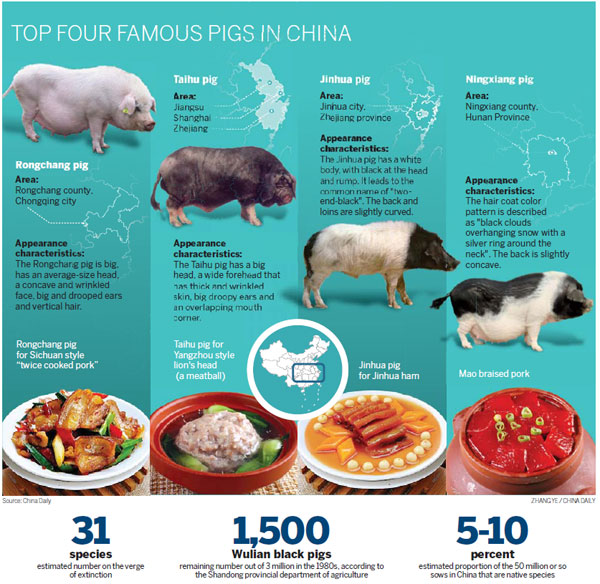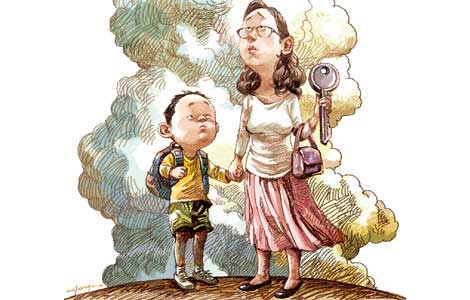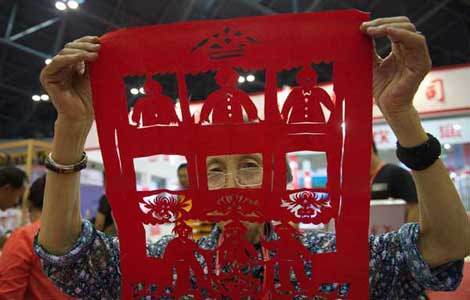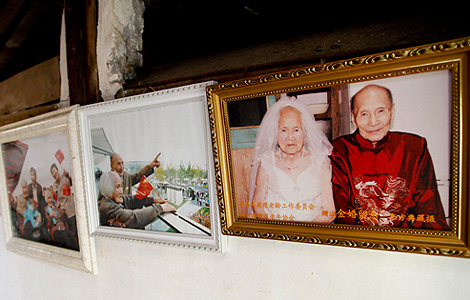Domestic pig breeds at risk of dying out
Updated: 2013-07-08 07:12
By An Baijie in Beijing and Zhou Wenting in Shanghai (China Daily)
|
||||||||
Farmer Zhang Qiang considers his pigs not just livestock, but national treasures.
He is among a handful of Chinese breeders who still specialize in native species - in his case, Wulian black pigs. Most others have switched to imported breeds.
"Almost all pork on the market in China is from species that originated overseas," said 41-year-old Zhang, who has two farms in Shandong province's Wulian county.
Pigs brought in from abroad grow faster and have leaner meat, Zhang said. "But they just don't taste as good."
So three years ago, he began to buy up every Wulian black pig he could find.
"We covered thousands of kilometers and went to hundreds of remote villages in the mountains," he said. "After searching for six months we'd collected just 30 pigs."
Today Zhang has 150 sows and more than 1,300 hogs. They are all that remain of the Wulian black pig, which in the 1980s numbered 3 million, according to Shandong's Department of Agriculture.
The pig, distinctive for its short legs, short neck and bright hooves, was listed among the province's endangered species of poultry and livestock in April 2009.
China is the world's biggest pork producer. The country's production last year was 53.3 million metric tons, almost 50 percent of the global total.
But research has found that more Chinese native pigs are dying out.
Wang Linyun at Nanjing Agricultural University said native species account for just 5 to 10 percent of the 50 million or so sows in China, while other experts estimate that 31 species are on the verge of extinction.
A Ministry of Agriculture survey from 2004 to 2008 showed four breeds, including the Shenxian in Hebei province and the Xiangcheng in Henan province, have already disappeared.
To reverse the trend, the government has placed 34 species under State-level protection, which means they cannot be slaughtered.
Hybrid species
China has been importing pigs for more two decades, according to the National Commission of Livestock and Poultry Genetic Resources, which was set up by the Agriculture Ministry in 2007.
It says about 16,000 animals were shipped in from 1991 to 2000, and 2,000 to 5,000 more have arrived every year since then.
The most-common breeds are Yorkshire and Berkshire, both from Britain; Landrace, which originated in Denmark; and Duroc, from the United States.
Many are also hybrid species. In May, a Shanghai company paid 20 million yuan ($3.26 million) for 865 "high-end custom swine" from the US, the highest amount ever paid for an imported breed.
For farmers, the decision to switch to foreign pigs comes down to simple economics: Compared to native species, they grow faster, have a better fat-to-meat ratio and yield higher returns.
"The proportion of lean meat for a native breed is 35 percent, while for a foreign breed it is 65 percent," said Han Xuejun, general manager of Shanghai Xiangxin Livestock Poultry Co. "Excessive fat is not what people want today."
He said his company had visited six farms in the US over the past two years to select pigs in the top 20 percent in terms of quality out of the 1.5 million on the US National Swine Registry.
More lean meat also means higher profits for meat-processing companies, said An Baoshou, a livestock trader in Shandong's Zhucheng city.
The cost of keeping a native pig is roughly double that for an import, which is about 14 yuan per kilogram.
"Pig farmers look at market demand and are driven by profits," said Yang Zhenxi, secretary-general of the Shanghai Swine Trade Association. "They won't keep native varieties if no one is willing to pay a higher price for the meat."
However, he added that he feels the industry has taken the easy option of importing animals rather than investing time and money into nurturing native breeds.
"The overriding problem is that no one in the industry or in government is willing to do realistic research to improve Chinese breeds," he said. "It takes time to carry out scientific research, and the effects are often slow in coming.
"People think it's more convenient to just bring in what others have done."
Instead of developing native breeds, Yang said, the country's measures are akin to those used to protect pandas. For example, he said, the government spends millions of yuan to ensure the survival of 10 boars and 100 sows in each of Shanghai's five native varieties.
"These breeds are not for sale at any price," he said. "Yet the offspring they produce is coming from a very small population, which is not conducive to the species' health or development."
Academics also agree that the failure to use imported breeds to develop the genetic code of Chinese species is a missed opportunity.
Pan Yuchun, a professor at Shanghai Jiao Tong University's School of Agriculture and Biology, is among those suggesting urgent reforms.
"If we import a breed but don't cultivate it, we'll simply have a cycle of introduction and degradation, no matter how prized the breed," he said. "The key objective of importing breeds should be so they can play a role in boosting the genetic system of our species."
Rising sales
Wulian farmer Zhang conceded that foreign breeds are more cost-efficient. Most pigs are sold when they reach 100 kg, and while it takes at least a year for one of his pigs to reach that size, it takes an imported animal just five months.
"Feeding a native species is also expensive, as they require more grain," he said. As a result, Zhang charges up to 160 yuan a kg for his pork, five to six times the average price.
Yet he insisted he is sticking with Wulian black pigs, and predicted the market will swing in his favor.
Sales have increased in recent years, he said, especially after reports in 2011 that pigs supplied to Shuanghui Group, China's largest meat-processing company, had been given fodder contaminated with clenbuterol, a banned additive often referred to as lean-meat powder.
"Our target buyers are families who own cars more expensive than 200,000 yuan," Zhang said, although he has noticed more people are now willing to pay higher prices for safer, better-tasting pork.
"I believe native pigs will become a No 1 choice for families in the future," Zhang said. "Let the market make the final decision."
Contact the writers at anbaijie@chinadaily.com.cn and zhouwenting@chinadaily.com.cn
Fan Feifei contributed to this story.

(China Daily USA 07/08/2013 page8)
Most Viewed
Editor's Picks

|

|

|

|

|

|
Today's Top News
Boeing 777 passenger 'mumbled a prayer'
Ex-minister gets suspended death
Workers return after dispute
Job seekers should be cautious abroad
River pollution sparks criticism
Terror attack was planned: suspect
Booming security industry needs skilled youth
A bright future for native black pigs?
US Weekly

|

|














